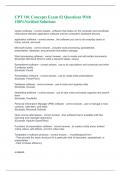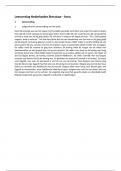Exam (elaborations)
BIO 1100 – HUMAN ANATOMY AND PHYSIOLOGY 1 COMPLETE EXAM (SOLVED 100% & VERIFIED) - GALEN
- Course
- BIO 1100
- Institution
- Galen College Of Nursing
BIO 1100 – HUMAN ANATOMY AND PHYSIOLOGY 1 COMPLETE EXAM (SOLVED 100% & VERIFIED) - GALEN
[Show more]












